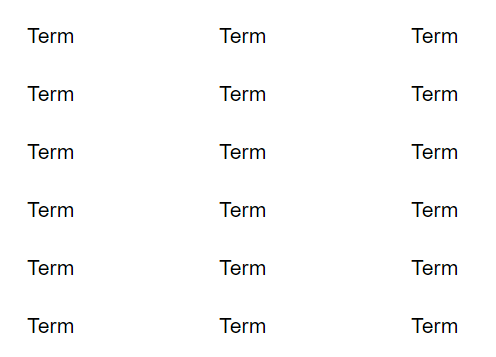
The end of the school year is high time for review. Make your experience EPIC with the review to end all reviews!
As the school year starts to come to a close, a couple of things are certain.
Student motivation will be soaring high. (Not!)
Reviewing previous content gets more and more important.
There are lots of ways to make review engaging, but my students have always responded to review games. They get the competitive juices flowing, and they put a new premium on knowing your stuff inside and out.
Whether an Olympics is coming up or not, you can use this review game that created excitement in my classroom -- in Olympic proportions!
In my classes, we called it the Spanish Class Olympics.
In Spanish Class Olympics, we use lots of the common review games I've always incorporated into my class. We just package them together in a weeklong cumulative competition. It gives students some extra incentive to come to class every day and bring their best!
Here are some of the pieces of that epic experience:
(Note: Remember, you don't have to use the whole experience as it is here! Customize it, add/remove/change games or even use one individual review game all by itself.)

1. Theme music
This really set the tone. If you want class to sound like the Olympics, you need the anthem! Music can help set students' minds in a place and time they recognize.
Every day of the Spanish class Olympics, as students walked in the room, I played the NBC theme music for the Olympics: Bugler's Theme by Leo Arnaud.

2. A leaderboard
Gamification is a hot topic in education right now. When we can bring game elements into learning, it can be very motivating for students.
I created a leaderboard in Google Drawings and updated it every day. We used three teams because the math seemed to work well for the class sizes and the arrangement of the games.
To schedule the whole week, I picked five games my Olympic teams would play. You'll see some of the games in the sections below, but a week might look like this:
- Monday (Game 1): Trashketball
- Tuesday (Game 2): Trashketball (they REALLY liked trashketball)
- Wednesday (Game 3): Row wars
- Thursday (Game 4): Flyswatters
- Friday (Game 5): Kahoot!
The winner of each game (the gold medalist!) got five points. Second place (silver medalist) got three points. Third place (bronze medalist) got one point. Any of these suggestions can be modified to fit your class best.
I kept track of the overall scores on the leaderboard and showed the leaderboard at the beginning of class each day of the Olympic games.
After getting the Spanish class Olympics all planned out, I pulled together some of my students' favorite review games. Some had a tech component. Others were paper-based or used lap dry-erase whiteboards. There's a good chance you've heard of one or more of them ... but maybe not!
This is a snapshot of what I used in the classroom in 2016 -- plus some updated things I would use today. Of course, substitute to fit your needs!

3. Game: Trashketball
That's a combination of a trash can and basketball. (I'm from Indiana. Basketball is life.)
We set up a trash can at one end of the room. (Trash bag and all the trash taken out, of course.)
Using pieces of string, we created shooting lines for different point values. We split the class into three teams. (Again, sticking with the three teams in the overall Olympics theme.)

Working together, the teams answered questions. If they answered correctly, they got a point and got to choose a line to shoot from. The farther from the trash can, the more points they were worth.
Over time, we added lots of new rules.
LIFELINES: For one, we started using "lifelines" like in the game show "Who Wants to Be a Millionaire." One lifeline was "step" -- take a big step forward before shooting. Another lifeline was "reshoot" -- shoot a missed shot again. The team only got to do this once per game, and we kept track of lifelines on the class whiteboard.
POINT MULTIPLIERS: At some point, a student asked, "What happens if I bounce it in -- on purpose?" I thought for a second and said, "Double points." They liked that!
Later, another student asked, "What if I bank it off the chalkboard?" This was hard because the chalkboard was running alongside the trash can. I said, "Double points." 😁
Then, another excited student asked, "Wait ... what if I bank it off the chalkboard AND bounce it in?" "Double double points ... quadruple points." 😆
What I loved about this was that my students came up with the special rules to the game. I suggested things. They suggested things. We decided the rules as a group. That made the game special!
You can use my special rules -- or suggest them to your students -- if you want. Or, as time goes on, you and your students can come up with new rules little by little. It's fun and it builds community!

4. Game: Row wars
This is a fast-paced small-group game that can get the adrenaline pumping! It's great for quick "term and definition" practice.
TEAM ORGANIZATION FOR OLYMPICS: Usually, I like to break the class into six groups. However, with a three-team Olympics format, that can be kind of tricky.
- If I had a class of 18 or more, that means each Olympic team has six or more students. In that case, I divided each Olympic team into two smaller teams. Example: Olympic Team 1 was divided into Team 1-1 and Team 1-2.
- If I had a class of 17 or fewer, that means each team has six or fewer students. In that case, we just kept the same three Olympic teams.
GAME PLAY: Teams would sit down in columns. Each team needs at least three players, and if there are more than three, they can sit behind the other players on their team and sub in and out during each round (more on that later) ...

I distributed a slip of paper face down to the first person from each team (and they wrote their team number on the back). For each round of the row wars game, I picked five words for students to define. (This game works well for basic recall questions ... anything that can be done quickly!)
The slip of paper looked something like this ... (except I put the vocabulary words in place of "round 1 word 1", etc.)

Make a copy of the Row Wars cards (Google Docs)
When I said "go" ...
- the first person on the team flips the sheet over, looks at the questions, answers one (just one!) and passes it back to the second person on the team
- the second person answers one (just one!) question and passes it back to the third person
- third person answers and passes up to second person
- second person answers and passes up to first person
- first person answers the final question and puts the slip of paper on a chair or desk in front of their group (the yellow squares in the diagram above)
Here's how the scoring works:
- Points for order of finish: First team done gets 6 points. Second team done gets 5 points. Third team done gets 4 points. (And on and on and on.)
- Points for answers: Each incorrect answer subtracts a point from the total.
- You can't get a negative score.
- Example: A team finishes third, so they start with four points. They get two questions wrong, so you subtract two points. They get two points for that round.
Tally the scores and add them to the team's running total. Play as many rounds as you'd like. We usually play six rounds.
When the game is over, determine a winner:
- With 18 or more students: Add the scores of the both sub-teams together to get the team's final score. (i.e. If Team 1-1 had 16 points and Team 1-2 had 14 points, add them together for a final Olympic Team 1 score of 30.)
- With 17 or fewer students: The team's final score is the team's final score. 🙂

5. Game: Flyswatters
This is another fun one to practice vocabulary or quick questions. Display a grid of terms on a projector screen (or write them on sticky notes and put them on the board). It looks something like this (fill in your own terms, of course) ...

Copy the flyswatter game grid for your projector screen (Google Docs)
You'll need two flyswatters. I've always kept several in my room just in case one is misplaced or if one breaks during an exceptionally lively game. (It has happened!)
Ideally, this is a two-team game, where a student from each team stands on opposite sides of the projector screen. When you call out a definition, the first player to swat the term gets the point. (In Epic Review Olympics, just rotate the teams at the screen ... Team 1 vs. Team 2, Team 2 vs. Team 3, Team 3 vs. Team 1 and on and on and on ...)
When a team swats the correct term, it gets a point. I will print a sheet of the terms and use it for two things -- to cross off terms as I call them AND to tally score for the teams. (If you want to go through the terms twice, put a line through the word the first time and then put an X through it the second time.)

6: Game: Kahoot!, Quizizz, Quizlet Live, Gimkit, Blooket ...
When I started playing the Spanish Class Olympics, Kahoot! (kahoot.com) was still a newer game. (I know, I know ... makes me look old, right???)
Since then, lots of similar review games have been released that work in this Olympics review format, like ...
- Quizizz (quizizz.com)
- Quizlet Live (quizlet.com)
- Gimkit (gimkit.com)
- Blooket (blooket.com)
When I used these games in the Spanish class Olympics, we'd play full-class games where each student played independently. (We didn't group students into Olympics teams.)
When the game was over, I would figure out each Olympic team's top three finishers. The place for each finisher became their score, and we added the top three scores. The goal was to get the lowest score.
Example:
- Team 1's three best finishers were 2nd, 4th and 7th
- Team 2's three best finishers were 1st, 5th and 6th
- Team 3's three best finishers were 3rd, 8th and 9th
- Add the places for all three teams (Team 1: 2+4+7=13, Team 2: 1+5+6=12, Team 3: 3+8+9=20).
- The lowest score is first, next lowest is second and highest is third. (In our example, Team 2 is first, Team 1 is second and Team 3 is third.)
If you're looking for more of a team effort, several of these review game platforms have a "play by team" option. That could simplify the scoring for the Olympics.
Other things to consider for your own epic Olympics review:
- Closure and celebration: How will you celebrate the winners?
- Data: With all of the data you collect from the review games, how can you use that to provide specific follow-up instruction based on concepts your students struggled with?
- Theme: Is there a different theme (other than the Olympics) that you could use instead, adjusting any of the resources above?
Do you have a review game that your students get excited about? Please describe it in a comment below. Let's gather lots of options together in the comments section. If we do, we'll have a great list that we can all use to make our Epic Review Olympics games even more epic!
For notifications of new Ditch That Textbook content and helpful links:
Are you looking for quality, meaningful professional learning that both equips and inspires teachers?
Matt provides in-person and virtual keynotes, workshops and breakout sessions that equip, inspire and encourage teachers to create change in their classrooms. Teachers leave with loads of resources. They participate. They laugh. They see tech use and teaching in a new light. Click the link below to contact us and learn how you can bring Matt to your school or district!
Is Matt presenting near you soon? Check out his upcoming live events!




Recently made an Escape Room “Break out the new Olympic sport” using short passages (2nd graders) about various topics related to the Olympics. The one-word answers for questions following each passage are collected on a recording sheet that has some of the letter spaces numbered. When students compile the numbered letters the answer will solve a riddle: What sport will be new to the Olympics in 2024?
ANSWER: Breakdancing!
On a side note: Our end-of-the-year ELA unit is research. Each student is researching an Olympian (past or present), event, or country. As a craft, we are making laurel wreaths from paper plates and construction paper. When they ESCAPE I will take their picture wearing their wreath and a sign that they ESCAPED.
[…] The skill can be part of a game that's fueled by academics. For instance, my students played "trashketball" where they shot a ball in an empty trash basket for points. The farther away, the more points they […]
[…] a theme from the great Matt Miller, I opted for the Epic Review Olympics. Planned ahead, before Christmas Break. Made a Jeopardy review for one day, planned out the rest, […]
Thank you for this post. We had the Olympics Review for our Biology End-of-Course Test in Texas. The test is broken down into 5 Categories; therefore, we played 5 days worth of review games. The students were very engaged. Thanks for your blogs; they are encouraging!
Thank you Katharine! Five categories, five days … perfect! 🙂
[…] End the school year with Epic Review Olympics (free templates!) | Ditch That Textbook […]
I am a big fan of the new Quizlet live where students need to work in cooperative groups. My students LOVED it.
I like to play Scategories at the end of a semester. You make the categories. Examples:colors, -ar verbs, questions, irregular verbs, months, numbers, etc. I place students in groups of three or four. Students have one minute (you can adjust the time) to write down five Spanish words that fit in the category. At the end of the time they say their answers to the group members. Tienes _____? Students only receive points for answers they write that no one had in their group. You can do as many categories as you like. At the end they total their points.
Quizlet review games (Scatter, Gravity, Live)
Martina Bex’s The Totally Unfair Game, “Strip” Bingo
Mrs. Bex may not have made up those two games, but I learned about them from her website.
Quizlet Live and the Totally Unfair games would make for the best competitions.
We play a game called Scoot using task cards. I place a task card on each desk. Students number their paper with the coordinating number of the cards. ie 25 cards number to 25. I then have them rotate or scoot around them room every 30 seconds. You could give longer if the questions were lengthy. Every few questions I have them sit down where ever they happen to be and we have a “commercial break.” During the breaks i show various videos we have watched throughout the year over the different topics we are reviewing with the task cards. My kids love anything by Flocabulary! He has a song for everything! After all questions are answered they go back to their seats and we go over the questions and their correct answers together.
Another game I have played with my classes is called Grudgeball.
Here is the website I found it on: http://toengagethemall.blogspot.com/2013/02/grudgeball-review-game-where-kids-attack.html
Fun game at all age levels.
Here are the rules in a shorter version if you don’t want to read the whole blog.
1) Divide the class into 5-6 teams.
2) Each team starts with 10 Xs(points) already up on the board under their team. For example:
Team 1 Team 2
X X
X X
X X
etc. etc.
3) Each group gets a question.
4) On the website it says when they get the question correct they take away 2 Xs.
I actually changed that to takeaway 1 X.
5) This is where my rules differed from the website. Setup 2 places to shoot from. One year I had a lot of soccer players so I created a “goal” out of masking tape on the back of my door. The players would then kick from the line.
6) If made they take away another X from a different team. If they shoot from the farthest line then they get to take away more Xs. When taking away Xs, you can only remove 1 X from a team at a time.
7) I even added in a steal factor. If the team in front of you misses the question, then the next team gets a chance to steal. If they get it correct then they take away an X from a team. Then the team that just stole will get their turn. Keep the question going around until a team answers it. Or save it for the end.
8) If you lose all your Xs then the way to stay in is get a question correct which will add 2 Xs back to your score. Plus if they make a basket they get to take away points from another team.
9) The issue I came across was being negative to those that tried to shoot. I also made every student shoot(even if they are reluctant at first). I made it clear I would give a paper review if any negativity happened.
Surprisingly your athletes do not do well when shooting, which makes it very funny to sit back and watch.
If you have any questions then please email me.
I also use the flyswatter game, dry-erase boards, and Kahoot for games. I find the students thirst for variety, so I’m always looking for something new that is also engaging and effective. I’ve also started incorporating Quizizz, although it’s more of an individual rather than team activity. I like to use the “Eggspert” buzzer that I bought from Teacher’s Discovery and have teams rotate their members up to the buzzers for each question (I prefer the corded to the wireless, partly for batteries but also for complaints about lag). Somewhat similar to your “trashketball”, I use a toy dart gun and draw a bulls-eye on the board. A team will send a member up to shoot the gun to determine how many points their question could be worth. If the shooter answers their question correctly within 10 seconds, they earn their points that they shot. If they do not answer correctly within 10 seconds, each team has a dry-erase board on which they are to write the answers out and can earn half of the points if they spell the answer correctly and display it to me within an additional 10 or 20 seconds depending upon the length of the answer. Lastly, I like to use a pop culture translation game where I try to incorporate vocabulary and grammar we have covered by translating the titles of popular movies, TV shows, and music artists into Spanish and have the students group up to try to translate them back into their original English titles. I don’t let them use technology to search as that can be too easy and I like to use the activity as a way to expose the students to using Spanish-English/English-Spanish dictionaries since many of them have never seen them before.